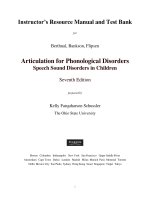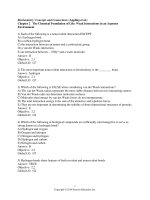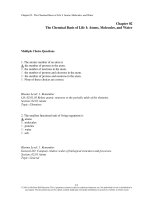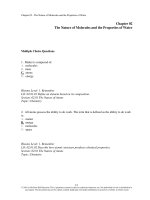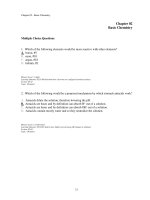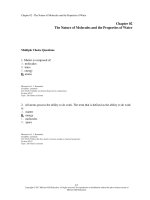Concepts in biology 14th edition enger test bank
Bạn đang xem bản rút gọn của tài liệu. Xem và tải ngay bản đầy đủ của tài liệu tại đây (228.48 KB, 33 trang )
Chapter 02 - The Basics of Life: Chemistry
Chapter 02
The Basics of Life: Chemistry
Multiple Choice Questions
1. An atom that has gained electrons is a
A. reactant.
B. negative ion.
C. positive ion.
D. compound ion.
Bloom's Level: 2. Understand
Learning Outcome: Discriminate between atoms and elements; molecules and compounds.
Section: 02.02
Topic: Chemistry
2. An atom with twelve electrons, twelve protons, and fourteen neutrons has a mass number
of
A. fourteen.
B. twenty-four.
C. thirty-eight.
D. twenty-six.
Bloom's Level: 2. Understand
Learning Outcome: Discriminate between atoms and elements; molecules and compounds.
Section: 02.02
Topic: Chemistry
2-1
Chapter 02 - The Basics of Life: Chemistry
3. A hydroxide ion has an oxygen atom
A. only.
B. and an extra electron.
C. and a hydrogen atom, and an extra electron.
D. and a hydrogen atom, and an extra proton.
Bloom's Level: 1. Remember
Learning Outcome: Discriminate between atoms and elements; molecules and compounds.
Section: 02.02
Topic: Chemistry
4. A negative charge is characteristic of a(n)
A. positive ion.
B. electron.
C. neutron.
D. proton.
Bloom's Level: 1. Remember
Learning Outcome: Discriminate between atoms and elements; molecules and compounds.
Section: 02.02
Topic: Chemistry
5. Solutions are always comprised of
A. solvents and solute.
B. liquids and solids.
C. water and salts.
D. compounds and ions.
Bloom's Level: 2. Understand
Learning Outcome: Differentiate among solution, solvent, and solute.
Section: 02.07
Topic: Chemistry
2-2
Chapter 02 - The Basics of Life: Chemistry
6. The greatest amount of kinetic energy is found in
A. gases.
B. liquids.
C. solids.
D. colloids.
Bloom's Level: 2. Understand
Learning Outcome: Summarize the difference between potential and kinetic energy.
Section: 02.03
Section: 02.04
Topic: Chemistry
7. All chemical reactions
A. involve the creation of new atoms.
B. involve a change in chemical bonds.
C. are dangerous.
D. create energy.
Bloom's Level: 2. Understand
Learning Outcome: Contrast chemical bonds and hydrogen bonds.
Learning Outcome: Discriminate between atoms and elements; molecules and compounds.
Section: 02.06
Topic: Chemistry
8. A covalent bond is
A. the attraction that one atom has for another atom.
B. the attraction between two atoms, formed by the sharing of electrons.
C. formed between the positive charge of a hydrogen atom in one molecule and the negative
charge of a nitrogen atom in another nearby molecule.
D. the attraction between a positive ion and a negative ion.
Bloom's Level: 1. Remember
Learning Outcome: Contrast chemical bonds and hydrogen bonds.
Section: 02.06
Topic: Chemistry
2-3
Chapter 02 - The Basics of Life: Chemistry
9. Protons = 7, neutrons = 10, electrons = 7. The mass number of this atom is
A. seven.
B. ten.
C. fourteen.
D. seventeen.
Bloom's Level: 3. Apply
Learning Outcome: Discriminate between atoms and elements; molecules and compounds.
Section: 02.02
Topic: Chemistry
10. An acid is a substance that, in solution, releases
A. oxygen ions in H2SO4.
B. hydrogen ions, for example, HCl.
C. —COOR ions from beer.
D. chloride ions from NaCl.
Bloom's Level: 1. Remember
Learning Outcome: Identify compounds that are acids, bases, or salts.
Section: 02.09
Topic: Chemistry
11. A particle in the atom that has neither a negative nor a positive electrical charge is the
A. electron.
B. element.
C. isotope.
D. neutron.
Bloom's Level: 1. Remember
Learning Outcome: Discriminate between atoms and elements; molecules and compounds.
Section: 02.02
Topic: Chemistry
2-4
Chapter 02 - The Basics of Life: Chemistry
12. In the expression C6H12O6 2C2H5OH + 2CO2, the products are
A. C6H12O6.
B. C6H12O6 + zymase.
C. zymase + 2C2H5OH + 2CO2.
D. 2C2H5OH + 2CO2.
Bloom's Level: 3. Apply
Learning Outcome: Explain the difference between reactants and products.
Section: 02.08
Topic: Chemistry
13. The correct symbol for a hydroxide ion is
A. H-.
B. H+.
C. (OH)-.
D. (OH)+.
Bloom's Level: 1. Remember
Learning Outcome: Identify compounds that are acids, bases, or salts.
Section: 02.09
Topic: Chemistry
14. Kinetic energy is best defined as
A. the energy of position.
B. the energy of electrical charge.
C. the energy of motion.
D. stored energy.
Bloom's Level: 2. Understand
Learning Outcome: Summarize the difference between potential and kinetic energy.
Section: 02.04
Topic: Chemistry
2-5
Chapter 02 - The Basics of Life: Chemistry
15. Which one of the following statements is false concerning matter?
A. Matter is anything that has mass and takes up space.
B. Air is matter.
C. All matter has the same density.
D. The phases of matter are determined by the relative amounts of energy in the matter's
molecules.
Bloom's Level: 2. Understand
Learning Outcome: Contrast matter and energy.
Section: 02.01
Section: 02.02
Topic: Chemistry
16. When two atoms share a pair of electrons, this type of chemical bond is
A. ionic.
B. covalent.
C. hydrogen.
D. negative-positive.
Bloom's Level: 2. Understand
Learning Outcome: Discriminate between atoms and elements; molecules and compounds.
Section: 02.06
Topic: Chemistry
17. Given that an unknown atom's mass number (AMU) is 27, its combination of particles
could be
A. 27 electrons, 16 neutrons, 16 protons.
B. 27 neutrons, 27 protons, 27 electrons.
C. 15 neutrons, 12 electrons, 15 protons.
D. 16 electrons, 11 neutrons, 16 protons.
Bloom's Level: 3. Apply
Learning Outcome: Discriminate between atoms and elements; molecules and compounds.
Section: 02.02
Topic: Chemistry
2-6
Chapter 02 - The Basics of Life: Chemistry
18. A base can be defined as
A. a hydroxide ion acceptor.
B. an attraction between a positive ion and a negative ion.
C. a substance that gives up hydrogen ions when dissolved in water.
D. a substance that gives up hydroxide groups in a solution.
Bloom's Level: 1. Remember
Learning Outcome: Identify compounds that are acids, bases, or salts.
Section: 02.09
Topic: Chemistry
19. The smallest particle of an element that still retains the properties of that element is a(n)
A. atom.
B. proton.
C. electron.
D. element.
Bloom's Level: 1. Remember
Learning Outcome: Discriminate between atoms and elements; molecules and compounds.
Section: 02.02
Topic: Chemistry
20. A chemical reactant is one that
A. enters into a chemical reaction.
B. is the newly formed molecule.
C. is at a point when both sides of the equation are equal.
D. during photosynthesis, is one molecule of sugar and six molecules of oxygen.
Bloom's Level: 1. Remember
Learning Outcome: Explain the difference between reactants and products.
Section: 02.08
Topic: Chemistry
2-7
Chapter 02 - The Basics of Life: Chemistry
21. An isotope is an atom of an element that varies in mass number due to variation in the
number of
A. atoms.
B. protons.
C. neutrons.
D. electrons.
Bloom's Level: 2. Understand
Learning Outcome: Explain the difference between reactants and products.
Section: 02.02
Topic: Chemistry
22. A substance that is a solid
A. contains a large amount of oxygen.
B. contains molecules that are packed tightly together and vibrate in place.
C. is bonded very tightly (covalent).
D. contains a large amount of hydrogen bonds.
Bloom's Level: 1. Remember
Learning Outcome: Describe the differences among liquids, solids, and gases.
Section: 02.05
Topic: Chemistry
23. An atom that has lost electrons is a
A. cation.
B. neutral atom.
C. molecule.
D. anion.
Bloom's Level: 2. Understand
Learning Outcome: Discriminate between atoms and elements; molecules and compounds.
Section: 02.02
Topic: Chemistry
2-8
Chapter 02 - The Basics of Life: Chemistry
24. If a particular atom has 27 electrons, 27 protons, and 31 neutrons, its mass number would
be
A. 52.
B. 54.
C. 56.
D. 58.
Bloom's Level: 3. Apply
Learning Outcome: Discriminate between atoms and elements; molecules and compounds.
Section: 02.02
Topic: Chemistry
25. A solution that contains an excess of protons is(are)
A. hydroxide ions.
B. an acid.
C. a base.
D. the pH.
Bloom's Level: 1. Remember
Learning Outcome: Identify compounds that are acids, bases, or salts.
Section: 02.09
Topic: Chemistry
26. AgNO3 + NaCl AgCl + NaNO3. The AgNO3 in the equation is called a(n)
A. reactant.
B. acid.
C. product.
D. base.
Bloom's Level: 2. Understand
Learning Outcome: Explain the difference between reactants and products.
Section: 02.08
Topic: Chemistry
2-9
Chapter 02 - The Basics of Life: Chemistry
27. An isotope shows which of the following?
A. A change in atomic number
B. Inability to form compounds
C. A change in mass number
D. More electrons
Bloom's Level: 2. Understand
Learning Outcome: Discriminate between atoms and elements; molecules and compounds.
Section: 02.02
Topic: Chemistry
28. A material composed of atoms vibrating in place
A. has high kinetic energy and is a gas.
B. has low kinetic energy and is a liquid.
C. has low kinetic energy and is a solid.
D. has high kinetic energy and is a solid.
Bloom's Level: 2. Understand
Learning Outcome: Summarize the difference between potential and kinetic energy.
Section: 02.04
Topic: Chemistry
29. Which of the following is a chemical reaction that is also known as digestion?
A. phosphorylation
B. dehydration synthesis
C. acid-base
D. hydrolysis
Bloom's Level: 1. Remember
Learning Outcome: List the five types of chemical reactions associated with all living things.
Section: 02.08
Topic: Chemistry
2-10
Chapter 02 - The Basics of Life: Chemistry
30. Which kind of chemical reaction involves the attachment or removal of a phosphate
group?
A. oxidation-reduction
B. acid phosphorylation
C. phosphorylation
D. hydrolysis
Bloom's Level: 2. Understand
Learning Outcome: List the five types of chemical reactions associated with all living things.
Section: 02.08
Topic: Chemistry
31. Which of the following is an acid?
A. K2SO4
B. NaNO3
C. CaCO3
D. H3PO4
Bloom's Level: 1. Remember
Learning Outcome: Identify compounds that are acids, bases, or salts.
Section: 02.09
Topic: Chemistry
32. An atomic particle with a weight of one, and a positive electrical charge is a(n)
A. electron.
B. proton.
C. neutron.
D. isotope.
Bloom's Level: 1. Remember
Learning Outcome: Discriminate between atoms and elements; molecules and compounds.
Section: 02.02
Topic: Chemistry
2-11
Chapter 02 - The Basics of Life: Chemistry
33. 6CO2 + 6H2O C6H12O2 + 6O2. In this reaction O2 is
A. a reactant.
B. a product.
C. a reactant and a product.
D. neither a reactant nor a product.
Bloom's Level: 2. Understand
Learning Outcome: Explain the difference between reactants and products.
Section: 02.08
Topic: Chemistry
34. One atom of sodium has a mass number of 22 units; another atom of sodium is 23 units.
These two atoms are
A. nonreactive.
B. unstable.
C. ions.
D. isotopes.
Bloom's Level: 1. Remember
Learning Outcome: Explain the difference between reactants and products.
Section: 02.02
Topic: Chemistry
35. Which kind of attractive force holds two molecules together?
A. ionic bond
B. hydrogen bond
C. covalent bond
D. sticky bond
Bloom's Level: 1. Remember
Learning Outcome: Explain how atoms stick together to form compounds.
Section: 02.06
Topic: Chemistry
2-12
Chapter 02 - The Basics of Life: Chemistry
36. A solution with a high concentration of hydrogen ions could have a pH of
A. 2.
B. 6.
C. 9.
D. 11.
Bloom's Level: 1. Remember
Learning Outcome: Work with the pH scale.
Section: 02.09
Topic: Chemistry
37. The attraction between a positively charged atom and a negatively charged atom within
the same molecule is
A. ionic bonding.
B. hydrogen bonding.
C. covalent bonding.
D. ions.
Bloom's Level: 2. Understand
Learning Outcome: Contrast chemical bonds and hydrogen bonds.
Section: 02.06
Topic: Chemistry
38. A scale used to indicate the strength of an acid or base is called a ____ scale.
A. thermodynamic
B. aquatic
C. pH
D. reduction
Bloom's Level: 1. Remember
Learning Outcome: Work with the pH scale.
Section: 02.09
Topic: Chemistry
2-13
Chapter 02 - The Basics of Life: Chemistry
39. The part of an atom without a charge is a(n)
A. ion.
B. neutron.
C. electron.
D. molecule.
Bloom's Level: 1. Remember
Learning Outcome: Discriminate between atoms and elements; molecules and compounds.
Section: 02.02
Topic: Chemistry
40. Which of the following indicates "reactant"? C6H12O6 + O2 CO2 + 6H2O
A. C6H12O6 + O2
B. H2O
C. CO2
D. None of the choices is correct.
Bloom's Level: 2. Understand
Learning Outcome: Explain the difference between reactants and products.
Section: 02.08
Topic: Chemistry
41. In the expression 2H2S + 3O2 2H2O + SO2, which is the acid?
A. H2S
B. O2
C. SO2
D. H2O
Bloom's Level: 3. Apply
Learning Outcome: Identify compounds that are acids, bases, or salts.
Section: 02.09
Topic: Chemistry
2-14
Chapter 02 - The Basics of Life: Chemistry
42. An ion having eleven protons, twelve neutrons, and ten electrons will have a charge of
A. +.
B. -.
C. ++.
D. --.
Bloom's Level: 2. Understand
Learning Outcome: Differentiate among atomic weight, atomic number, atomic mass, and mass number.
Section: 02.02
Section: 02.06
Topic: Chemistry
43. A list of all of the elements in order of increasing atomic number is called the
A. pH.
B. law of thermodynamics.
C. phase of matter.
D. periodic table.
Bloom's Level: 1. Remember
Learning Outcome: Describe the information found in the periodic table of the elements.
Section: 02.02
Topic: Chemistry
44. The mass of a given volume of matter is expressed as
A. weight.
B. energy.
C. density.
D. gravity.
Bloom's Level: 1. Remember
Learning Outcome: Describe the differences among liquids, solids, and gases.
Section: 02.01
Section: 02.05
Topic: Chemistry
2-15
Chapter 02 - The Basics of Life: Chemistry
45. The reaction C6H12O6 + O2 CO2 + 6H2O is which type of chemical reaction?
A. hydrolysis
B. transfer
C. dehydration synthesis
D. oxidation-reduction
Bloom's Level: 1. Remember
Learning Outcome: Explain the difference between reactants and products.
Section: 02.08
Topic: Chemistry
46. Which rule states that atoms attempt to acquire an outermost energy level with eight
electrons through chemical reactions?
A. octet
B. atomic stability
C. hybridization
D. full energy level
Bloom's Level: 2. Understand
Learning Outcome: Describe the information found in the periodic table of the elements.
Section: 02.02
Topic: Chemistry
47. A person jogging displays what kind of energy?
A. potential
B. kinetic
C. nuclear
D. sweat
Bloom's Level: 5. Evaluate
Learning Outcome: List the five types of chemical reactions associated with all living things.
Section: 02.08
Topic: Chemistry
2-16
Chapter 02 - The Basics of Life: Chemistry
48. HCl + NaOH NaCl + H2O. This reaction is an example of a(n)
A. oxidation/reduction reaction.
B. hydrolysis reaction.
C. phosphorylation reaction.
D. acid-base reaction.
Bloom's Level: 2. Understand
Learning Outcome: Explain the difference between reactants and products.
Section: 02.08
Topic: Chemistry
49. The atomic number for carbon is 6. The isotope 14C has ____ neutrons.
A. 6
B. 8
C. 14
D. 20
Bloom's Level: 1. Remember
Learning Outcome: Discriminate between atoms and elements; molecules and compounds.
Section: 02.02
Topic: Chemistry
50. Given that an unknown atom's mass is 11, its combination of subatomic particles could be
A. 11 protons, 11 neutrons, and 11 electrons.
B. 6 protons, 5 neutrons, and 11 electrons.
C. 4 protons, 3 neutrons, and 4 electrons.
D. 5 protons, 6 neutrons, and 5 electrons.
Bloom's Level: 3. Apply
Learning Outcome: Discriminate between atoms and elements; molecules and compounds.
Section: 02.02
Topic: Chemistry
2-17
Chapter 02 - The Basics of Life: Chemistry
51. One molecule of sodium nitrate (NaNO3) contains ____ atoms.
A. 6
B. 5
C. 4
D. 3
Bloom's Level: 4. Analyze
Learning Outcome: Discriminate between atoms and elements; molecules and compounds.
Section: 02.02
Topic: Chemistry
52. The statement that energy is never created or destroyed is known as
A. thermodynamics.
B. kinetic molecular theory.
C. first law of matter and energy.
D. law of conservation of energy.
Bloom's Level: 1. Remember
Learning Outcome: Contrast matter and energy.
Section: 02.01
Topic: Chemistry
53. Which one of the following rows best represents a gas in relation to a solid or liquid of the
same compound?
A. Row 1
B. Row 2
C. Row 3
D. Row 4
Bloom's Level: 5. Evaluate
Learning Outcome: Describe the differences among liquids, solids, and gases.
Section: 02.05
Topic: Chemistry
2-18
Chapter 02 - The Basics of Life: Chemistry
54. Which one of the following is true with regard to the numbers of subatomic particles in an
atom?
A. The number of neutrons always equals the number of protons.
B. The number of electrons always equals the number of neutrons.
C. The atomic number always equals the number of protons.
D. The atomic number always equals the number of neutrons.
Bloom's Level: 1. Remember
Learning Outcome: Discriminate between atoms and elements; molecules and compounds.
Section: 02.02
Topic: Chemistry
55. The fact that all matter is made up of tiny particles that are in constant motion is known as
the
A. first law of thermodynamics.
B. energy motion theory.
C. kinetic molecular theory.
D. first law of solids.
Bloom's Level: 2. Understand
Learning Outcome: Describe the differences among liquids, solids, and gases.
Section: 02.01
Section: 02.05
Topic: Chemistry
56. The formulation Ca++Cl-2, indicates
A. covalent bonding between one calcium atom and two chlorine atoms.
B. one calcium ion that has gained two electrons and formed ionic bonds with two chloride
ions that have each lost one electron.
C. one calcium atom with two protons and two chlorine atoms that share one electron.
D. one calcium ion that has lost two electrons and formed ionic bonds with two chloride ions
that have each gained one electron.
Bloom's Level: 3. Apply
Learning Outcome: Contrast chemical bonds and hydrogen bonds.
Section: 02.06
Topic: Chemistry
2-19
Chapter 02 - The Basics of Life: Chemistry
57. One atomic mass unit (AMU) approximately equals the mass of one
A. proton.
B. electron.
C. nucleus.
D. proton plus the mass of one neutron.
Bloom's Level: 1. Remember
Learning Outcome: Discriminate between atoms and elements; molecules and compounds.
Section: 02.02
Topic: Chemistry
58. A bond in which the positive end of one polar molecule is attracted to the negative end of
another polar molecule is a(n)
A. covalent bond.
B. ionic bond.
C. electron bond.
D. hydrogen bond.
Bloom's Level: 2. Understand
Learning Outcome: Contrast chemical bonds and hydrogen bonds.
Section: 02.06
Topic: Chemistry
59. When a pencil falls from a tabletop to the floor
A. kinetic energy is converted to potential energy.
B. potential energy is converted to kinetic energy.
C. energy is created.
D. energy is destroyed.
Bloom's Level: 3. Apply
Learning Outcome: Summarize the difference between potential and kinetic energy.
Section: 02.03
Section: 02.04
Topic: Chemistry
2-20
Chapter 02 - The Basics of Life: Chemistry
60. The pH of a strong base is closest to
A. 2.
B. 6.
C. 9.
D. 12.
Bloom's Level: 3. Apply
Learning Outcome: Work with the pH scale.
Section: 02.09
Topic: Chemistry
61. A neutral atom with an atomic number of 15 will have ____ electrons in its outermost
energy level.
A. 3
B. 5
C. 8
D. 15
Bloom's Level: 2. Understand
Learning Outcome: Discriminate between atoms and elements; molecules and compounds.
Section: 02.02
Topic: Chemistry
62. Which one of the following represents the correct mass, location, and charge of a proton?
A. Row 1
B. Row 2
C. Row 3
D. Row 4
Bloom's Level: 5. Evaluate
Learning Outcome: Discriminate between atoms and elements; molecules and compounds.
Section: 02.02
Topic: Chemistry
2-21
Chapter 02 - The Basics of Life: Chemistry
63. The higher the pH,
A. the greater the hydroxide ion concentration.
B. the more acidic the solution.
C. the greater the hydrogen ion concentration.
D. the lower the pH number.
Bloom's Level: 2. Understand
Learning Outcome: Work with the pH scale.
Section: 02.09
Topic: Chemistry
64. A difference between an acid and a base is that
A. acids are harmful and bases are not.
B. acids release hydroxide ions and bases release hydrogen ions.
C. acids have a high pH value and bases have a low pH value.
D. acids have a low pH value and bases have a high pH value.
Bloom's Level: 2. Understand
Learning Outcome: Identify compounds that are acids, bases, or salts.
Learning Outcome: Work with the pH scale.
Section: 02.09
Topic: Chemistry
65. A magnesium ion contains twelve protons and ten electrons. A chloride ion contains
seventeen protons and eighteen electrons. Given this information, the chemical formula for
magnesium chloride is
A. MgCl.
B. Mg2Cl.
C. MgCl2.
D. Mg2Cl2.
Bloom's Level: 3. Apply
Learning Outcome: Describe the information found in the periodic table of the elements.
Section: 02.02
Topic: Chemistry
2-22
Chapter 02 - The Basics of Life: Chemistry
66. Which reaction below produces a salt?
A. KOH + H2O K+ + OH- + H2O
B. HC2H3O2 + H2O C2H3O2- + H+ + H2O
C. HCl + NaOH NaCl + H2O
D. C6H12O6 + C6H12O6 C12H22O11 + H2O
Bloom's Level: 2. Understand
Learning Outcome: Explain the difference between reactants and products.
Section: 02.08
Topic: Chemistry
67. Fluorine has the atomic number 9. The correct notation for a flouride ion is
A. F-.
B. F--.
C. F+.
D. F++.
Bloom's Level: 1. Remember
Learning Outcome: Discriminate between atoms and elements; molecules and compounds.
Section: 02.02
Topic: Chemistry
68. The energy level listed below with the most energetic electrons is
A. 1.
B. 2.
C. 3.
D. None of these. All energy levels contain electrons of equal energy.
Bloom's Level: 1. Remember
Learning Outcome: Discriminate between atoms and elements; molecules and compounds.
Section: 02.02
Topic: Chemistry
2-23
Chapter 02 - The Basics of Life: Chemistry
69. An atom that contains 8 electrons in its outermost energy level is said to be
A. inert.
B. reactive.
C. a cation.
D. a molecule.
Bloom's Level: 1. Remember
Learning Outcome: Discriminate between atoms and elements; molecules and compounds.
Section: 02.02
Topic: Chemistry
70. Which of the following is monatomic?
A. He
B. H2
C. O2
D. N2
Bloom's Level: 2. Understand
Learning Outcome: Discriminate between atoms and elements; molecules and compounds.
Section: 02.02
Topic: Chemistry
Short Answer Questions
71. List and define two types of chemical bonds.
COVALENT--attractive force between two atoms that share electrons
IONIC--attractive force between ions of opposite charge
HYDROGEN--attractive force between polar molecules
Bloom's Level: 1. Remember
Learning Outcome: Contrast chemical bonds and hydrogen bonds.
Section: 02.06
Topic: Chemistry
2-24
Chapter 02 - The Basics of Life: Chemistry
Multiple Choice Questions
72. In which one of the following situations do the molecules have the greatest amount of
energy?
A. Ice in a Coke
B. Cold tap water
C. Water vapor
D. Water condensed on your windshield
Bloom's Level: 3. Apply
Learning Outcome: Summarize the difference between potential and kinetic energy.
Section: 02.04
Topic: Chemistry
73. If an atom has the atomic number 4 and the atomic mass 9.012 it will
A. have 5 electrons.
B. have 5 neutrons.
C. have 9 electrons.
D. weigh 13.012 atomic mass units.
Bloom's Level: 2. Understand
Learning Outcome: Discriminate between atoms and elements; molecules and compounds.
Section: 02.02
Topic: Chemistry
74. A measure of the average kinetic energy of the molecules making up a substance is known
as
A. temperature.
B. heat.
C. potential.
D. phase of matter.
Bloom's Level: 1. Remember
Learning Outcome: Summarize the difference between potential and kinetic energy.
Section: 02.01
Section: 02.03
Topic: Chemistry
2-25



